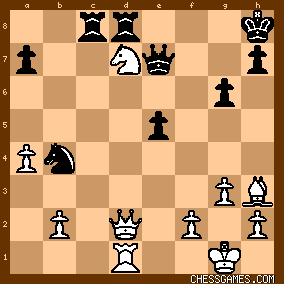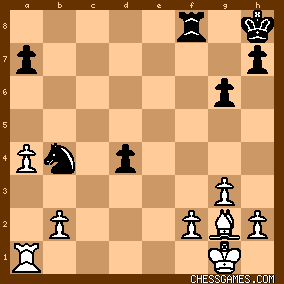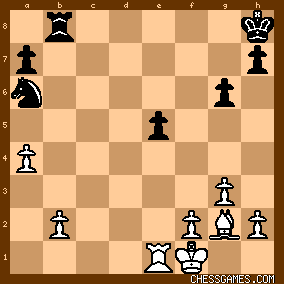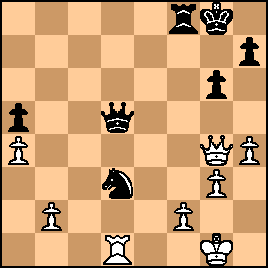| Jan-17-04 | | Benjamin Lau: Max Euwe, a former world champion, was once asked to name "My Gravest Error." He rejected crass oversights, which are accidental blunders. He wrote, "One might just as well try to explain why a double six came up when two dice were thrown." And so he chose an error in judgment, which he made against Vasily Smyslov in the 1953 Candidates’ Tournament. Euwe prepared carefully for the Candidates’ because he was making a final attempt "to regain my place among the very top chess-players of the world." In rounds one and two, he beat Alexander Kotov and Yefim Geller. "I was feeling like a newly born hero," he wrote, "when, in the third round, I was seated opposite Smyslov. When one is in such a mood, everything succeeds. In our game I had chosen an enterprising opening, and during the middle game I had sacrificed the exchange." (See the position at the 28th move) Euwe described 28. Qd6 as the "obvious" move. He noted that White threatens 29. Qf6+ and that Black would have to trade Queens by 28. ... Qa6+ 29. Qxa6 Nxa6 30. Nxb8 Rxb8. He wrote, "I looked at this ending for a few minutes: a pawn up; bishop against knight. My prospects were excellent, but doubtlessly against a tough end-game player like Smyslov, there would still be some hard work to do." Euwe also looked at 28. Qd2, which "seemed very solid," though he would be down an Exchange for a pawn. "Against Smyslov this could lead to an unhappy result," Euwe noted. And so Euwe searched for more in the 28. Qd6 line. He became fascinated by the variation, 28. Qd6 Qa6+ 29. Qxa6 Nxa6 30. Nxe5, threatening both 31. Nf7+ and 31. Nc6; but Black had 30. ... Rd2 "which is rather troublesome." Now comes the intellectual breakdown as described by Euwe: "I returned to my 28. Qd2 line, and herein lay my grave error. I quite FORGOT that in the first line with 28. Qd6 Qa6+ 29. Qxa6 Nxa6 I could regain the exchange by simply playing Nxb8. My analysis of Nxe5 instead of Nxb8 had so fascinated me that it had overshadowed and obliterated my original calculation .... It is very rare that a player forgets the outcome of a variation he has already calculated correctly." Hah! Rare for Euwe, but not for the rest of us. I’ve forgotten how many outcomes of countless variations that I’ve forgotten. In the game, Euwe played 28. Qd2 and eventually lost. http://www.worldchessnetwork.com/En... |
|
| Dec-05-04 | | Backward Development: of interest:
on smyslov's grunfeld
"Smyslov makes frequent use of this line of the Grunfeld, where black attacks the center pawns with c5 and e6, trades off on d5 and blockades the pawn by planting his knight at d6. Isolated and blockaded though it may be, the white d-pawn remains very strong nevertheless. Black must always be prepared for its advance, especially considering how difficult it will be for him to actually get either one of his knights from b6 or b8 to d6. The outcome of this game will depend on whether White finds an appropriate moment to advance the pawn to d6 and secure it there. If he can, then he will have the advantage; if not, black will obtain good counterchances. In my personal opinion, the system looks good for White. It is possible that smyslov now shares this opinion, since despite the succesful outcome of this game, he did not employ the system again, either at Zurich or at any other tournament there after."
on Euwe's familiarity with the Grunfeld
"Smyslov is dealing with a great expert on the Grunfeld. At the Amsterdam 1950 tournament, Euwe played a similar game against Pilnik, continuing here with 10.Nbc3. In the tournament book, Euwe noted that the move was not good and recommended 10.a4!(Euwe) Na6
11.Na3 ed
12.ed Nb4
12.Nc3!(Euwe again)
Smyslov goes into the line nonetheless, which gives this game added interest.
Curiously enough, in Game 129(Round 19)against Keres, Euwe played 10.Nec3, and in his notes calls this move stronger than 10.a4.
Both moves seem adequate to me."
after black's 14th move
"Smyslov plays an active defense: now he threatens to occupy d3 with a piece, severing the enemy communications between flanks. Advancing his pawn to d6, with the exchange sacrifice that follows, appears to be the logical end of white's entire setup, but it would have had more effect after 15.a5."
after black's 21st move
"Two pawns, one of them passed and on the sixth rank, are sufficient compensation for the exchange; the maneuver Smyslov begins with this move, however, underscores the weakness of the pawn at d6. 22.Nb5 is now impossible, in view of 22...Rxb5, so the bishop has to retreat."
after black's 25th
"The picture looks hopeless for white, but his next move is quite pretty."
after white's 26th move
"The idea is to decoy the rook onto an unprotected square. Now if
...Rxd7
27.Bxe5+ Qxe5
28.Qxd7 Qxb2
29.Re1 and two of black's pawns are en prise. also poor is
26...Bxd4
27.Qxd4+ Kg8
28.Nf6+ Kh8
29.Nd5+ Kg8
30.Ne7+ Kf8
31.Qh8+ Kxe7
32.Re1+. "
after black's 29th move
"A brilliant resource which white overlooked. Black's queen reenters the fray elegantly and decisively threatening to win the pinned knight."
after black's 33th move
"Now black is a piece up, and the win is, as they say, a matter of technique. In the present instance, however, the technique will be anything but simple; for the piece white has, besides two pawns, some other chances as well: his king is better sheltered, and black's knight has no support points in the center. In general, black's plan will be to avoid exchanging queenside pawns, to find shelter for his king, to bring his knight to the kingskde, and finally to attack the white pawns at f2 and b2 with overwhelming force.
The fulfilment of this plan requires exceptional restraint, deep calculation, and rapid assessment of the positions that occur along the way."
of the win
"Smyslov showed a high level of mastery and an incredible will to win in every phase of this tense game." |
|
Feb-15-07
 | | plang: 7..e5 is considered to be the main line today. If Euwe had played 16 a5 (or perhaps played it earlier) it would have given him the option of following up Bb7 with a6. Instead of taking the exchange Smyslov could have played 17..Qd6 which appears to give him a reasonable position. The combination with 26 Nd7! was very pretty and should have led to a pawn-up endgame. After Euwe throws away his advantage with 28 Qd2? Smyslov's technique is impressive. Smyslov has been patiently trying to move his knight to the kingside. 56 Rd6 seems to help him do that. 58 Rd5 would have been a tougher defense with the idea of 58..Qb7? 59 Qe4 and if 59..Re7 the 60 f4 and if 59..Ng4 the 60 Rh5+. |
|
| Mar-10-07 | | Hesam7: 31.Rad1 looks like an improvement:

click for larger view[1] 31...Rc2 32.Qe3 Rxb2 33.Qxa7 Nc6 34.Qe3 Nb8 35.Qc1 Rb4 36.Nxb8 Rdxb8 37.a5 Rf8 38.a6 Qf6 39.Qe3 Qxa6 40.Qxe5+ Qf6 41.Qxf6 Rxf6 42.Rd2 and I think White has good drawing prospects. [2] 31...Rc7 32.Qe1 a5 33.Bg4 e4 34.Qe3 and I do not see how Black makes any progress. This is not an exhaustive analysis so any comments are welcome. What do Bronstein or Najdorf say about this in their books on the tournament? |
|
| Jul-07-07 | | Ulhumbrus: <Backward Development> Your quotation " Smyslov showed a high level of mastery and an incredible will to win in every phase of this tense game" may or may not be from the translation by Jim Marfia. The translation by Oscar Friedman is worded slightly differently, and I find the latter more enjoyable to read : "Smyslov showed great mastery and an extraordinary will to win at all phases of this tense game". I don't know which of the two translations conveys more accurately the meaning of the original Russian text. |
|
Jul-22-12
 | | Peligroso Patzer: <Hesam7: 31.Rad1 looks like an improvement: *** [diagram omitted] [analysis omitted] This is not an exhaustive analysis so any comments are welcome. <What do Bronstein or Najdorf say about this> in their books on the tournament?> Bronstein wrote: “Euwe thinks <31. Rd1> would have been better, but I do not see any great difference: <31. … Rc7 32. Qe1 Nc6 33. b4 Qxb4 34. Nxe5 Qxe1+ 35. Rxe1 Nxe5 36. Rxe5 Rd2>, and Black must win.” (BRONSTEIN, David, <Zurich International Chess Tournament 1953>, tr. fr. 2nd Russian Ed. By Jim Marfia, Dover Publications, Inc. ©1979, at p. 30) Najdorf wrote simply: “More resistance was offered by <30. Rd1>”. (NAJDORF, Miguel, <Zurich 1953: 15 Contenders for the World Chess Championship>, tr. by Taylor Kingston, Russell Enterprises, Inc. ©2012, at. P. 69.) The position, of course, is extremely complicated. FWIW, after <31. Rd1 Rc7 32. Qe1>, Fritz 13 considers Black’s best to be <32. … Kg7>, with an evaluation of approximately -1.7 (<- +>). |
|
Jul-22-12
 | | Peligroso Patzer: Rather interestingly, Bronstein (<op. cit.>, at p. 30) does not directly criticize Smyslov’s dubious <26. … f6?> (Better: <26. … Bg7> or <26. … Bxd4>), merely giving at that juncture in the game an alternative line with <26. … Qa6+> in which “White obtains the better endgame”. Bronstein does acknowledge, however, in his comment re: <28. Qd2[?]>, that with “the better move <28. Qd6>”, White could have forced Black to go into a line involving a trade of Queens [<28. ... Qa6+ 29. Qxa6 Nxa6 30. Nxb8 Rxb8 31. Re1>] in which Black would have had to “try to save himself in a difficult pawn-down endgame”. (Ibid., at p. 30) |
|
| Jul-23-12 | | Hesam7: <<Peligroso Patzer>: Bronstein wrote: “Euwe thinks <31. Rd1> would have been better, but I do not see any great difference: <31. … Rc7 32. Qe1 Nc6 33. b4 Qxb4 34. Nxe5 Qxe1+ 35. Rxe1 Nxe5 36. Rxe5 Rd2>, and Black must win.” (BRONSTEIN, David, <Zurich International Chess Tournament 1953>, tr. fr. 2nd Russian Ed. By Jim Marfia, Dover Publications, Inc. ©1979, at p. 30) Najdorf wrote simply: “More resistance was offered by <30. Rd1>”. (NAJDORF, Miguel, <Zurich 1953: 15 Contenders for the World Chess Championship>, tr. by Taylor Kingston, Russell Enterprises, Inc. ©2012, at. P. 69.) The position, of course, is extremely complicated. FWIW, after <31. Rd1 Rc7 32. Qe1>, Fritz 13 considers Black’s best to be <32. … Kg7>, with an evaluation of approximately -1.7 (<- +>).> Thank you!
First Bronstein's line is not correct after 31. Rd1 Rc7 32. Qe1 Nc6, his move (33. b4?) is a blunder. Instead White should continue with: 33. Qc3! after which it seems Black has to take on d7: 33. ... Rdxd7 34. Rxd7 Rxd7 35. Qxc6: 
click for larger viewAnd White has good drawing chances.
Second after Fritz's line: 31. Rd1 Rc7 32. Qe1 Kg7 33. b3 it is difficult for Black to avoid ... Nc6 and then line above: 33. ... a5 34. Qe4. |
|
| Jul-23-12 | | Hesam7: <Peligroso Patzer: Rather interestingly, Bronstein (<op. cit.>, at p. 30) does not directly criticize Smyslov’s dubious <26. … f6?> (Better: <26. … Bg7> or <26. … Bxd4>), merely giving at that juncture in the game an alternative line with <26. … Qa6+> in which “White obtains the better endgame”. Bronstein does acknowledge, however, in his comment re: <28. Qd2[?]>, that with “the better move <28. Qd6>”, White could have forced Black to go into a line involving a trade of Queens [<28. ... Qa6+ 29. Qxa6 Nxa6 30. Nxb8 Rxb8 31. Re1>] in which Black would have had to “try to save himself in a difficult pawn-down endgame”. (Ibid., at p. 30)> After 28. Qd6 Black is not forced to go for Bronstein's line. Instead he could play 28. ... Rxd7 29. Qxd7 Qc5 30. Kg1 Rf8 31. Qd2 Qd4 32. Qxd4 exd4

click for larger view
With ... Rd8, ... a5 and then bringing the King to the center. This seems much better than Bronstein's ending:

click for larger view
Black's pieces have no coordination not to mention the how big of an improvement moving the pawn from e5 to d4 is. |
|
| Jul-23-12 | | RookFile: <Benjamin Lau:
Euwe described 28. Qd6 as the "obvious" move. He noted that White threatens 29. Qf6+ and that Black would have to trade Queens by 28. ... Qa6+ 29. Qxa6 Nxa6 30. Nxb8 Rxb8. He wrote, "I looked at this ending for a few minutes: a pawn up; bishop against knight. My prospects were excellent, but doubtlessly against a tough end-game player like Smyslov, there would still be some hard work to do." > The difference between Capa and Euwe. Give Capa white and Qd6 gets banged out after 1 minute. The ending is black's problem, not white's. Basically, Euwe tried too hard, and did not conserve his resources for this game. You don't just make one good move - you leave yourself with enough energy and resources to make one good move after another. Euwe realized this himself later. |
|
| Jul-23-12 | | Hesam7: <RookFile: Basically, Euwe tried too hard, and did not conserve his resources for this game. You don't just make one good move - you leave yourself with enough energy and resources to make one good move after another. Euwe realized this himself later.>
But you expect that from a 19 year old Tal, not from a pragmatic technical player like Euwe, specially not when he is 52! There has been talk that Euwe experimented with stimulants to enhance his performance, for example: <<pim>: The Dutch gm Hans Ree wrote that Euwe's second during this tournament, Cortlever, had told him that Euwe was experimenting with pills to get more energy. When a game was adjourned, everybody thought it was lost for white, whereas Euwe was optimistic and thought he could win. When the pill stopped working, Euwe saw his position was lost. Ree suggests that Cortlever's information might be connected to this game (Ree, Doping, in Schaakstukjes, 1993).> was posted here: Euwe vs Smyslov, 1948. |
|
| Jul-23-12 | | RookFile: I think this may be why Euwe was harder on himself for this game than anybody else was. Losing to Smyslov in the 1950's? Through the lens of time, we can say there is no disgrace in that. |
|
| Dec-01-15 | | Howard: 37...Nd3 would have won quickly, but Smyslov missed it. |
|
Jan-22-16
 | | cwcarlson: After 28.Qd6 Bronstein gives Rb6 29.Qe7 Nc6 30.Qf6+ Kg8 31.Rd1, but 31.Bh3 forces resignation. Also 58.Rd5 Rf5 59.f3 (not 59.Ra5?? Qb7+ 60.f3 Nc4) Qc7 60.Rc5 might hold. |
|
| Oct-29-21 | | FM David H. Levin: <Hesam7: First Bronstein's line is not correct after 31. Rd1 Rc7 32. Qe1 Nc6, his move (33. b4?) is a blunder. Instead White should continue with: 33. Qc3! after which it seems Black has to take on d7: 33. ... Rdxd7 34. Rxd7 Rxd7 35. Qxc6:
click for larger viewAnd White has good drawing chances.>
I believe that Black should maneuver his queen to d4 and king to g7, while keeping his rook on the second rank. Then, if White safeguards his b- and f-pawns, Black prepares ...e3 to expose White's king and ultimately force a queen trade. So I think Black should start with 35...Rb7. One sample continuation is 36. Qc2 Kg7 37. b3 Qd6 38. Bf1 Qd4 39. Bc4 e4 40. Qe2 Re7 41. Kg2 Re5 42. Qe1 a5 43. Qe2 h6 44. Qe1 e3 45. fxe3 Qxe3 46. Qa1 Kh7 47. Qd1 Qe4+ 48. Kf2 Rf5+ 49. Kg1 Qe3+ 50. Kg2 Qf2+ 51. Kh1 Qf3+ 52. Qxf3 Rxf3. I go into more detail at https://www.redhotpawn.com/forum/on.... |
|
| Oct-29-21 | | RookFile: From reading the notes about Euwe above, you get the sense that the guy was too smart to even be playing chess, from the things he thought about. There are some guys who would have just banged down 28. Qd6 and hit the clock without a second thought. Sometimes ignorance is bliss. |
|
| Nov-01-21 | | FM David H. Levin: <Howard: 37...Nd3 would have won quickly, but Smyslov missed it.>
click for larger view37...Nd3 (bringing about the diagram position) involves some pretty tactics. 38. Rd2 runs into a fork after 38...Rxf2! 39. Rxf2 (39. Qc8+ Rf8) 39...Qh1+!! 40. Kxh1 Nxf2+ and 41...Nxg4. Similarly, 38. Qe2 Rxf2 39. Qxf2 Qh1+ 40. Kxh1 Nxf2+ and 41...Nxd1. A pleasing dual. And 38. f4 (after 37...Nd3) would lose the b-pawn with check after 38...Qd4+ 39. Kg2(or h2). |
|
Jul-03-22
 | | nizmo11: It is interesting to compare Bronstein's and Najdorf's comments in their respective tournament books:
<Bronstein> on move 24.Kh8: "As will later become clear 24...Kg7 was better:
it is important that in one variation that the king defend the pawn f7."
This seems to refer to his variation 25.Bd4 Be5 26.Nd7! Rxd7 27. Bxe5+ Qxe5 28.Qxd7 Qxb2 29.Re1 that would work for Black with king at g7.
<Najdorf>: "26.Nd7!! f6 Smyslov, in extremely dangerous position, wants to avoid draw, [...] but with 26...Bxd4+ 27.Qxd4+ Kg8 28.Nf6+ the game should end in a draw."
His comment stops here, and does not mention that the correct move now is 28...Kf8! 29.Nxh7+ Kg8.
Bronstein missed 28...Kf8 and gives only 28...Kh8[?] 29.Nd5+ Kg8 30.Ne7+ Kh8 31.Qh8+ Kxe7 32.Re1+ and White wins. |
|
|
|
|





































